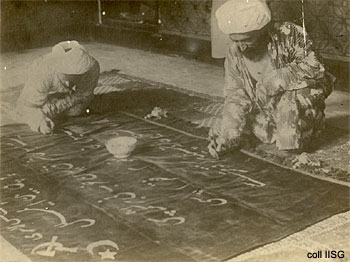
Estonian Nazis parade on July 30, 2011.
By Rupen Savoulian

Estonian Nazis parade on July 30, 2011.
By Rupen Savoulian

Painting slogans for the Congress of the Peoples of the East, September 1920, Baku. Photo from IISG.
By John Riddell
July 21, 2011 -- http://johnriddell.wordpress.com, posted at Links International Journal of Socialist Renewal with the author's permission -- Just under a century ago, the newly founded Soviet republic embarked on the world’s first concerted attempt to unite diverse nations in a federation that acknowledged the right to self-determination and encouraged the development of national culture, consciousness and governmental structures. Previous major national-democratic revolutions – in Britain, France, Germany, Italy, the United States – had been made in the name of a hegemonic nation and had assimilated, marginalised or crushed rival nationalities. The early Soviet regime, by contrast, sought to encourage, rather than deny, internal national distinctiveness.

"Emancipated woman -- build up socialism." Poster by Strakhov-Braslavskij A. I., 1926.
By John Riddell
June 12, 2011 -- The following working paper was presented to the Toronto conference of Historical Materialism on May 16, 2010. It first appeared on John Riddell's blog and is posted at Links International Journal of Socialist Renewal with the author's permission.
* * *
When we celebrate International Women’s Day, we often refer to its origins in US labour struggles early last century. Less often mentioned, however, how it was relaunched and popularised in the 1920s by the Communist Women’s International. Moreover, this movement itself has been almost forgotten, as have most of its central leaders.
The Communist Women’s International was founded by a world gathering of communist women in 1921, which elected a leadership, the International Women’s Secretariat, reporting to the executive of the Communist International, or Comintern. It also initiated the formation of women’s commissions in national parties, which coordinated work by women’s bodies on a branch level, and called periodic international conferences of Communist women.

May Day in St Petersburg, 1917.
By Didier Limon, translated, edited and introduced by Keith Rosenthal
December 22, 2010 -- This phenomenal, historical and analytical study by Didier Limon -- which first appeared in Autogestion: études, débats, documents, cahier no. 4, pp. 65-111 (Paris, December 1967) -- has, until now, not been translated into English. This is a shame on many levels for it stands nearly peerless in its meticulous treatment of the specific subject it takes up. That is, the debates and discussions surrounding the implementation of workers’ control of production within the first months after the October revolution of 1917 in Russia.

By Jim Green
April 17, 2011 -- Green Left Weekly -- With the 25th anniversary of the Chernobyl nuclear disaster falling on April 26, a debate is brewing over the estimated death toll. The debate has erupted with a heated exchange between prominent British columnist George Monbiot and anti-nuclear campaigner Dr Helen Caldicott. Monbiot claims the “official death toll” from Chernobyl is 43. Caldicott puts the death toll at 985,000. Someone's wrong. Perhaps they both are.
The debate over the Chernobyl death toll turns on the broader debate over the health effects of low-level ionising radiation and in particular the risk of cancer. The weight of scientific opinion holds that there is no threshold below which ionising radiation poses no risk and that the risk is proportional to the dose — the “linear no-threshold” (LNT) model.
By Doug Lorimer
[This article first appeared in the Democratic Socialist Party's internal discussion bulletin, The Activist, volume 10, number 7, August 2000.]
The Communist Party of Australia has recently published a pamphlet by David Matters entitled Putting Lenin's Clothes on Trotskyism which claims that the DSP's rejection of Trotsky's theory of permanent revolution is really a cover for its support for Trotskyism. However, the real purpose of the pamphlet is to criticise the DSP's position on the 1998 waterfront dispute.
This is made clear in the introduction to Matters' pamphlet by CPA general secretary Peter Symon:
In writing Putting Lenin's clothes on Trotskyism, David Matters has contributed to the task of clarifying ideas and maintaining the validity and truth of Marxism...
The attack on Marxism in the name of Marx, or on Lenin in the name of Lenin, is a particularly pernicious form which can easily mislead those who are not familiar with what Marx, Engels and Lenin actually said and wrote.
The pretension that Trotsky was a great Leninist is one of these misrepresentations and was refuted time and again by Lenin.

By Suzi Weissman[1]
[This paper was presented at a conference in Nottingham, England, in 2009. It is posted at Links International Journal of Socialist Renewal with Suzi Weissman’s permission. See also "Victor Serge: `dishonest authoritarian', `anti-worker anarchist' or revolutionary Bolshevik?"]